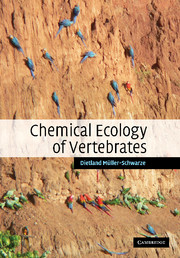Book contents
- Frontmatter
- Contents
- Preface
- Acknowledgements
- 1 The odorsphere: the environment for transmission of chemical signals
- 2 Properties of vertebrate semiochemicals
- 3 Odor production and release
- 4 Chemical cues in orientation and navigation
- 5 Chemoreception
- 6 Signaling pheromones I: discrimination and recognition
- 7 Signaling pheromones II: sex and alarm pheromones and evolutionary considerations
- 8 Intraspecific signals: priming pheromones
- 9 Development of intra- and interspecific chemical communication
- 10 Allomones I: chemical defense by animals
- 11 Allomones II: plant chemical defenses against herbivores
- 12 Kairomones and synomones
- 13 Practical applications of semiochemicals
- Glosssary
- References
- Index
4 - Chemical cues in orientation and navigation
Published online by Cambridge University Press: 23 November 2009
- Frontmatter
- Contents
- Preface
- Acknowledgements
- 1 The odorsphere: the environment for transmission of chemical signals
- 2 Properties of vertebrate semiochemicals
- 3 Odor production and release
- 4 Chemical cues in orientation and navigation
- 5 Chemoreception
- 6 Signaling pheromones I: discrimination and recognition
- 7 Signaling pheromones II: sex and alarm pheromones and evolutionary considerations
- 8 Intraspecific signals: priming pheromones
- 9 Development of intra- and interspecific chemical communication
- 10 Allomones I: chemical defense by animals
- 11 Allomones II: plant chemical defenses against herbivores
- 12 Kairomones and synomones
- 13 Practical applications of semiochemicals
- Glosssary
- References
- Index
Summary
Where will I find a patch of fresh grass?
The answer, my friend, is blowing in the wind.
With apologies to Bob DylanNec vident terras, sed in odorem earum natant. (They don't see the land, but swim following its smell.)
(Red deer, Cervus elaphus, when supposedly swimming from Cyprus to the mainland of Asia Minor.)
c. plinius secundus (Pliny the Older): Naturali Historiae, Book 8: Zoology; Land Animals, 115: De cervis, p. 89. Translated into German. Tusculum Library, Heimeran Verlag, 1976.Humans depending on fishing and hunting have learned at their peril about animal migrations very early on. Today we still marvel at how precisely migrating organisms time their departures and arrivals and almost never fail to find their destinations, even passing on this vital information to their offspring. Young wandering albatrosses circumnavigate the Southern Ocean many times in the course of 8 or more years, before they return to breed at exactly the same place they were born. What cues guide these migrants in their epic journey? We know how insects, fish, and birds use the sun, the stars, and the magnetic field of the earth. But what role do chemical cues play? The physical and biological environments abound with volatile chemicals that vertebrates might use to orient themselves in space. In air, point sources such as a volcano, a small pond, or a tree in bloom are available, as are landscape odors such as those from pinewoods or the ocean. Even ship-borne humans can smell large seabird rookeries on ocean islands from afar. Arriving from sterile Antarctica, an air passenger landing in New Zealand is overwhelmed by its steamy, musty, moldy greenhouse odor.
- Type
- Chapter
- Information
- Chemical Ecology of Vertebrates , pp. 60 - 81Publisher: Cambridge University PressPrint publication year: 2006



